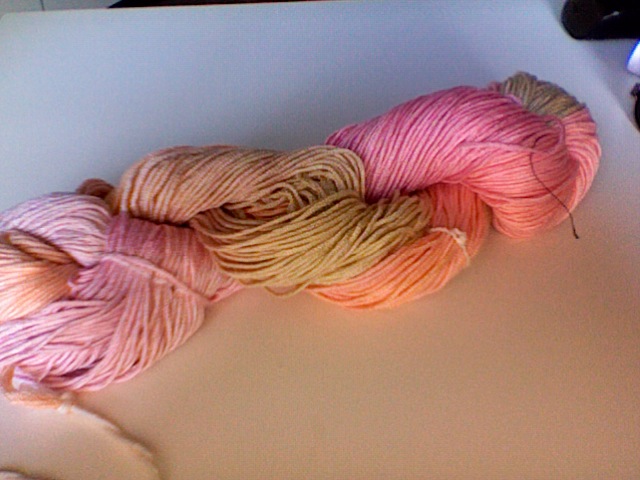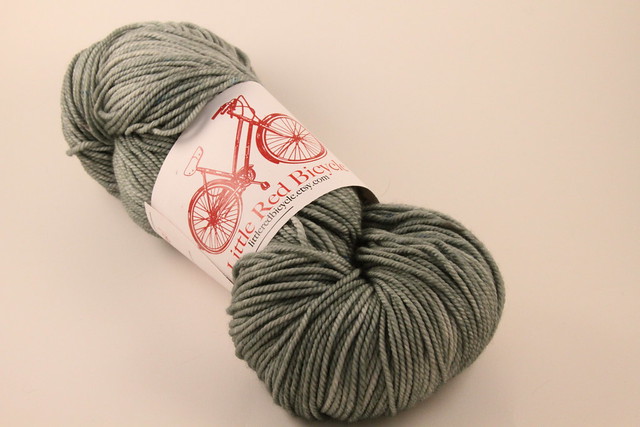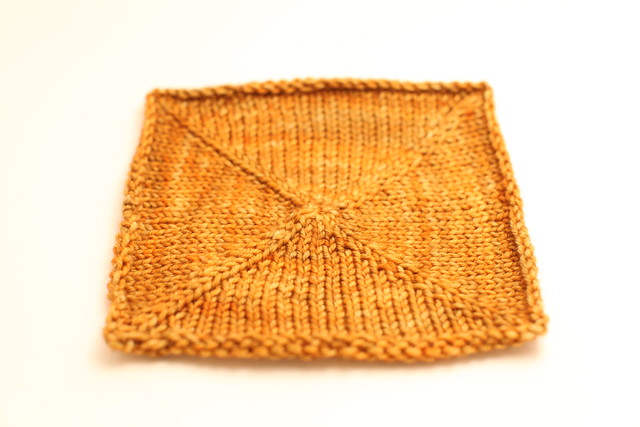There are tons of ways to take photos of finished objects, and I'll try to get to all of them, but for now I'm focusing on small objects, like toys, hats, gloves, and even skeins of yarn for your stash page.
I didn't use Ravelry's stash feature for AGES, and when I did, it was a series of badly-taken webcam photos that didn't represent the yarn in any useful way:
The color in this photo is off, the lighting's uneven, and parts of it are blurry. I can't even get a good feeling for the texture of this yarn in the photo-- is it soft and light, like a fingering weight yarn, or is it super heavy bamboo? Is it scratchy or silky? This photo basically tells me nothing except that I own some yarn that looks fairly like rainbow sherbet.
Now, I take all of my small object photos using a curl or lightbox. This method results in photos that have a clean, white background with no "setting" in the shot.
To accomplish this look, you don't actually need any fancy equipment... A white sheet or piece of posterboard can make a curl. To start, just attach the material to a vertical plane (wall or chairback) and let the fabric or paper drape toward you, creating a gentle curve. If using posterboard, I tend to favor the matte side (the side that typically has the price sticker on it), so there's no reflectivity. Once you've created a curl, you have to determine your light sources.
Lighting can be approached many ways. Natural light obviously depends on the weather. Using the sun can be great (and cheap!) but the best results occur in the shade or on an overcast day, where you get all the ambient light of the sun with none of the harsh shadows.
If using artificial light, I like to use opposing lights or a single overhead, diffused light. If you just put two lamps on opposite sides of a ball of yarn, you'd probably get some harsh shadows. Diffusing light makes it more even. A quick way to do this is via lampshades or the use of parchment paper. Parchment allows light to shine through, but breaks it up and makes it more even. It's also heat resistant, so BAM!
I followed a tutorial and constructed my own little lightbox. I then went to Home Depot and bought two cheap worklights and two "daylight" bulbs. My final result was this:
I'm using parchment on the sides to diffuse the light, which creates a great, even glow in the space. You can buy premade tents, but I like this as a cheap alternative. I keep this box in my guest room, under a lamp with a white bulb, so I can just turn on the light and get a good, quick image from it. In fact, the photos from yesterday's post were taken in the tent, with just the overhead lamp!
Super easy! Do you have any tricks for small photos like this?
- YX
Don't forget! Just a few more days to enter and win!






I need to make one of these with one of the big ole boxes that we've been getting here recently! Now, the next time Bryan wants a field trip to Home Depot, I can be excited about it too! Haha!!
ReplyDeleteDefinitely! I truly feel so happy when I look at my finished projects and they're all nicely photographed. I feel like I "owe it" to my projects to have them properly represented!
ReplyDelete